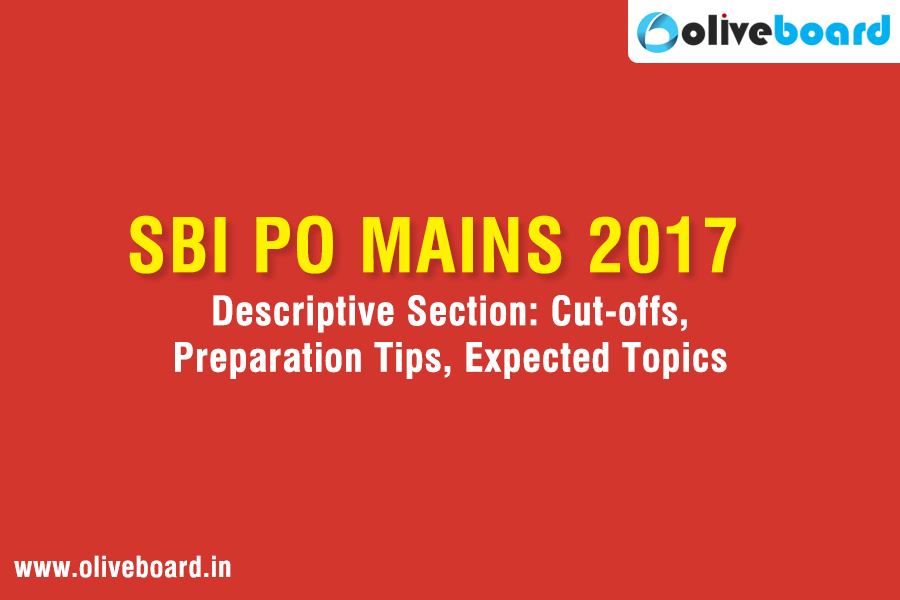The results of the SBI PO Prelims 2017 are out and the SBI PO Mains exam is scheduled on 4th June, 2017. As all of you must be knowing, the SBI PO Mains examination consists of a descriptive writing test of the English language. In this blog post, we will discuss all about the descriptive writing section: pattern, cut-offs, preparation tips and previous years’ topics.
SBI PO Mains 2017 Descriptive Test : Pattern
The Descriptive Test will be of 30 minutes duration with 50 marks.
It will consist of letter writing & essay writing. The candidates are required to qualify in the Descriptive Test by securing passing marks, to be decided by the Bank.
Note that the descriptive test paper of only those candidates will be evaluated who score qualifying marks in the objective tests and are placed adequately high as per total marks in objective test.
SBI PO Mains 2017 Descriptive Test : Cutoffs (2016)
| Maximum Marks | General | SC | ST | OBC | OH | VI | HI | |
| Descriptive Type Test (English Language) | 50 | 20 | 17.5 | 17.5 | 17.5 | 17.5 | 17.5 | 17.5 |
SBI PO Mains 2017 Descriptive Test : Essay Writing
What should an Essay comprise of?
An essay is nothing but a short piece of writing on a particular topic. What sets an essay apart is not just being error free in terms of grammar and spelling but also the structure and flow of ideas in the essay. A basic but ideal structure to follow is:-
1) Introduction:- This should contain a brief introduction of the topic with an explain the background of the topic. Use this section also to briefly mention your view on the topic before elaborating on that in the body paragraphs.
2) Body Paragraphs:- The body paragraphs (or the middle paragraphs) are used to present one’s point of view on the subject in a detailed manner. You should restrict the number of paragraphs here to 2 or 3. The purpose of the body is to list out in detail the examples that support your view. It is always advised to put forth your strongest argument first followed by the second strongest one and so on. Each paragraph should contain one idea and sentences supporting it.
3) Conclusion:- The conclusion is place to restate the main argument/view you made by showing the connections made between the different points in your essay. However, one should not use the same words to do so.
The conclusion should also not be a place to introduce any new idea or thought but just a summarizing of your main argument using some of the strongest evidence supporting it.
Plan Before You Type:-
Although it may seem like a waste of time, it is important to spend a few minutes to first plan and think about what you are writing instead of immediately writing. If you have 15 minutes for one essay, spending about 5 minutes on planning your essay can save a lot of time on thinking while you type. Most people who dont plan before writing tend to get stuck in the middle or run out of ideas and are forced to think after writing a portion of the essay. This will hamper the flow and structure of your essay if one tries to generate ideas while typing.
Spend a few minutes on outlining the points you want to make. Make rough points on the introduction, the stance you are taking along with supporting arguments. Make sure you have your sequence with the strongest arguments first and then the remaining arguments.
DOs and DONTs:-
- Make a time strategy while you practice. For eg: If it’s 15 minutes for one essay, then have 5 -7- 3 plan where you spend 5 minutes planning, 8 minutes typing and then 2 minutes to read through the final essay to eliminate any grammatical or spelling errors. Make sure you do get the time to read and check for any errors. You can tweak the time-break up and choose one that works for you.
- Stick to the word limit provided. If no word limit is provided, try to limit your essay to around 250-300 words.
- Avoid using colloquial, slang, SMS ‘lingo’ while you type. No using of “I’m”, “wat”, “thx”,”ASAP”, “gr8” etc. or use informal language such as ‘veggies’ instead of vegetables, ‘Kids’ instead of Children, ‘Anyways’ instead of Nevertheless etc.
- Use simple language. Even if your vocabulary is very strong, use words and sentences that you believe most of the readers will understand. No extra points are given for using difficult words that very few understand. In fact, it can be detrimental. For eg: “The deleterious effects of smoking…. ” vs ” The harmful effects of smoking… “
- Do NOT use “I think…”, “I feel… ” , “In my opinion” etc. Avoid the use of first person and second person pronouns throughout the essay.
- Do NOT make broad generalizations such as “Everyone knows that Narendra Modi is a good Prime Minister”. Instead one could say that “Several people believe that Narendra Modi is a good Prime Minister” and this statement can be supported by text in the essay.
Sample Topics for practice:
- Consequences of Brexit
- Merger of SBI with its associates
- Resentment over 7th Pay Commission
- MPC (Monetary Policy Committee) formation
- Rising NPAs of Indian Banks
- India’s NSG Debacle
- What to expect from the new RBI Governor
- 7% Growth in Indian Economy : Figures and Realities
- Make In India : Where we have reached
- 2 Years of Modi Government : Achievements and Challenges
Essay Writing Topics : SBI PO Mains 2016 Descriptive Section
- Effects of Pokemon Go
- Importance of the History of a Nation
- Positive Effects of the Hike in Salary of an Employee
SBI PO Mains 2017 Descriptive Test : Letter Writing
There are two types of letters asked in these exams are:-
- Informal letters (written to friends, relatives, parents, siblings (brother/ sister)
- Formal letters (written to bank manager, news editor, government dept/ officials etc.)
Broadly speaking, a letter, formal or informal must contain the following parts:-
- Address
- Body
- Conclusion
Format:
- Writer’s Address: The letter should have the writer’s information (address etc.) and the date. This informs the recipient of the letter when and where the letter was drafted by you. Also this gives a reference to the reader in case he plans to reply to your letter. The commonly accepted position of the heading is at the top-left or right corner. The address should be in short lines at the corner, each line beginning exactly from under the previous line. Each line should end with a comma and the last line with a full-stop. This is common for both formal and informal letters.
- Date: It is essential to mention the date at the end. E.g.: 6th June, 2017.
- In a formal letter, below the writer’s address, you are supposed to write the recipient’s address.
- Subject Line: It is absolutely imperative to write a subject in formal letters only.
- Salutation: An initial greeting or Salutation to the receiver of the letter: This contains the greeting to the reader. For e.g., if it’s a letter to your Brother it will “Dear Brother”, if it’s an official letter to a bank manager it will be “Respected Sir” or “Dear Sir”. The Salutation will be present below the heading.
- Body of the Letter: This is the main content of the letter, conveying the message to the reader. The style of writing will depend on the type of letter (More of which is given below).
(i) It’s important to split the body of long letters to smaller paragraphs. Each paragraph can address one small portion of the body. For e.g., the first paragraph might contain the background of the letter, the 2nd the course of action intended, and a final closing paragraph.
(ii) Try to avoid long sentences. Be clear and concise in your letter.
(iii) Do not leave room for ambiguity. Try to be as complete as possible.
(iv) Be careful with punctuation. A wrong punctuation mark can change the meaning and tone of the letter. - The courteous ending and Signature: On completing the body, it is important to have a courteous leave taking. These include “Yours Sincerely”, “Yours faithfully” etc. This is present on the right/left corner below the body of the letter. Please make sure that the ending starts with a Capital Case alphabet. Below this, a placeholder for your name is present.
Letter Writing Topics : SBI PO Mains 2016 Descriptive Section
- Letter to the editor (formal) : Increase in selfies among youth
- Letter to parents (informal) : New job in a new city and problem faced there
- Letter from a Principal to Parents (formal) : Importance of parents’ involvement in a child’s education
Hope this helps!
Click here to know how essays and letters are evaluated.
All the best!!

The most comprehensive online preparation portal for MBA, Banking and Government exams. Explore a range of mock tests and study material at www.oliveboard.in
Oliveboard Live Courses & Mock Test Series



